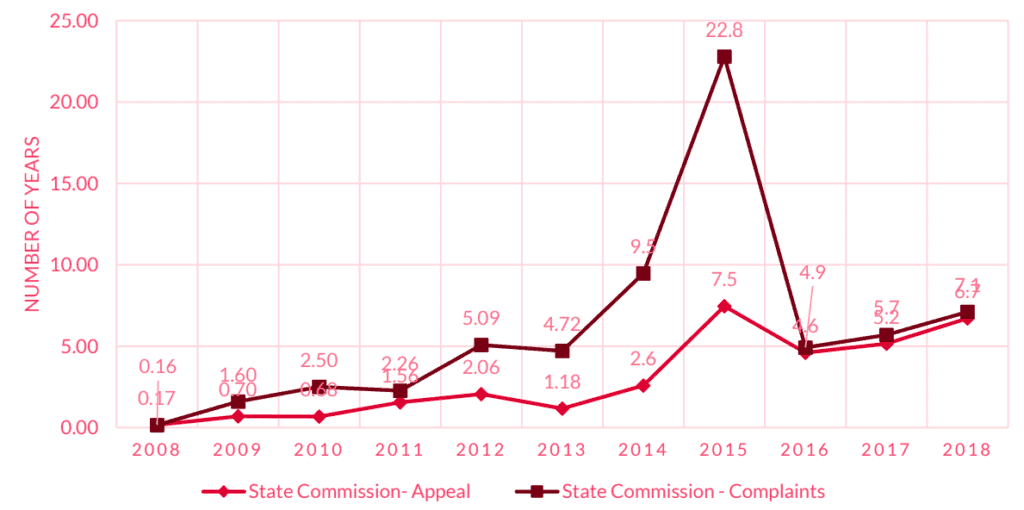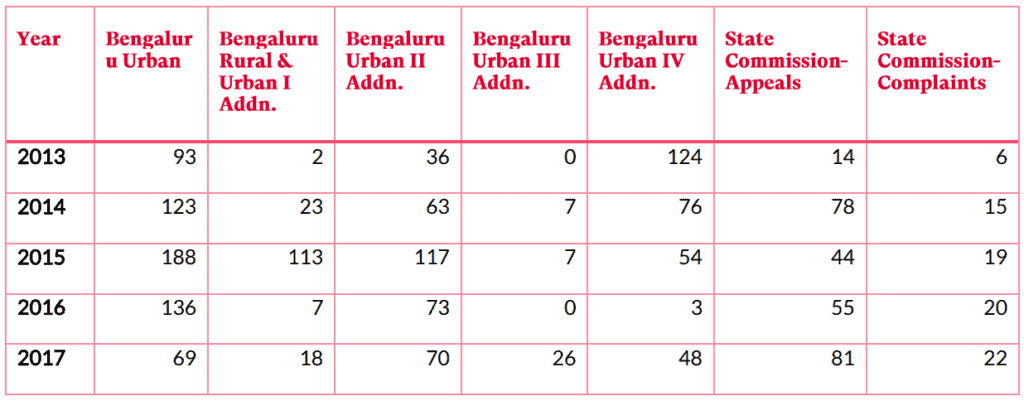How many of us consider approaching the consumer court for a faulty piece of electronics, for an insurance claim that’s not honoured or for services like warranty and maintenance contracts that are promised but not provided? What happens when you do? How long do you wait? And how many of us succeed?
The idea and intention behind setting up Consumer Dispute Redressal Commissions was to ensure swift and cost-effective access to justice to us, the consumers. Though it serves this purpose (in comparison to having to fight consumer cases in other courts, where it would take longer), a report by Vidhi Centre for Legal Policy says the existing system leaves much to be desired.
Vidhi’s research team analysed over 10,000 cases filed from 2013 to 2017 across five district commissions in Bengaluru Urban and one in Bengaluru Rural, as well as the Karnataka State Consumer Dispute Redressal Commission (KSCDRC). The analysis revealed that while disposal was largely in favour of consumers, it took almost two years, which far exceeds the time frame of three to five months fixed by law.
Favourable decisions for half of complainant consumers
“Consumer Commissions across the city display a trend of disposing cases in favour of the consumers,” says the report. “Overall, the success rate of complaints filed in State Commission or District Commission in Bengaluru is 51.8 per cent, while the decisions against the consumers are at an average of 24.3 per cent and those dismissed on ‘technical grounds’ are an average of 23.9 per cent”. It is interesting to note that nearly a quarter of the cases are dismissed on technical grounds.
So, while there are good chances of winning if the case is technically sound, one needs to be patient. The research report says 70-85% of the total number of disposals in the five-year analysis period (2013 to 2017) happened in the first two years. While appeals take about one year, complaints take almost two years for disposal, though the mandated time is 3-5 months
Bengaluru Commissions
It is important to note that the report analyses cases before the new Consumer Protection Act, 2019, came into force. The report also notes that the 2019 Act which replaces the 1986 Act, further strengthens the concept of ‘caveat venditor’ (let the seller beware), by imposing additional responsibilities on manufacturers, service providers, sellers and endorsers.
Pendency
Pendency is a major challenge and has gotten worse over the years. “As per the statistics report prepared by the State Commission, as of July 2019, a total of 10,433 complaints and appeals were pending in the State Commission… The Consumer Protection Regulations, 2005 require a Consumer Commission to dispose of at least 75 to 100 cases per month. However, in comparison to the approximately 225 cases being filed per month in the State Commission, a target of 75-100 disposals is simply not enough,” says the report.
“The steady inflow of cases and the limited capacity with KSCDRC have increased the pendency five-fold over the past ten years – from 2,148 appeals and complaints pending in 2009 to 10,433 in July 2019. Currently, Karnataka has the third highest number of pending consumer cases in the State Commissions after Uttar Pradesh (25,500) and Maharashtra (18,408).”
Considering the pendency and disposal of cases in 2018, it will take more than 6 years for the State Commission to dispose of all the pending appeals and more than 7 years to dispose of all the pending complaints if no new appeals and complaints were to be filed.

Adjournments
Adjournments are one of the major reasons for delays. The research team found that there were (average of) 7.5 adjournments per case at the arguments stage. Moreover, if an average interval of three to six weeks between two proceedings is added, it gives an idea of how delays of several weeks and months occur for each case. In some extreme cases (421 complaints and 131 appeals filed between 2013 and 2017 in the District Commissions and the State Commission situated in Bengaluru) the gap was 300 or more days between two proceedings.
Gopal Ratnam, secretary, Consumer Care Society, says their experience corroborates many of the findings of the report. “We have observed many of the issues that the report highlights in our work of several years. However, a deeper and qualitative analysis of some of these factors will lead to deeper understanding and perhaps solutions that will enable better functioning will emerge.
“For example, one of the reasons for delays is lack of technical expertise when a bench is dealing with a variety of complex matters pertaining to finance or insurance. Or when the manufacturer is not in the same state and many agencies have to be involved with the bureaucratic processes to be followed. There aren’t easy solutions but we believe the matters must be disposed of within a year.”
Other factors causing pendency
Among several reasons the report identifies, one is infrastructure and personnel. The report says despite 84% of sanctioned strength in district commissions and 90% sanctioned strength the State Commission was filled, interviews with administrative staff revealed that it wasn’t enough to meet the requirements.
Another challenge is uneven distribution of workload among the district commissions that are established to share caseload and dispose of matters efficiently. “Some District Commissions handle significantly more cases than others, resulting in inefficient use of available resources,” says the report.

Nature of complaints
Most complaints at the consumer courts relate to sectors such as insurance, housing, banking, road transport, airlines, telecom, postal, electricity, medical and defective household goods. Of these, housing, insurance and banking disputes were the most litigious categories. One in every five complaints is related to the housing sector. “The rapid urbanization of the city has led to a massive expansion of the housing sector. Such expansion might have contributed to an increase in housing disputes… 79.5 per cent of the pending complaints at the Bangalore Urban District Commission are housing disputes,” the report says.
In person representation
One of the important provisions of these commissions is in-person representation by the consumer without relying on lawyers or other agencies. However, most litigants prefer to hire advocates, the report says. Which adds to legal costs without enabling quicker disposal of cases.
“Out of 12145 complaints filed across District Commissions in Bengaluru between 2013 and 2017 only 1476 (12.2 per cent) complaints were represented by party in-person. In the same period, out of 13109 appeals and complaints filed in the State Commission, only 354 (2.7 per cent) were represented by party in-person.”

Online Dispute Resolution: The way forward?
Based on the analysis, the report suggests that the following measures be adopted to improve the effectiveness of Consumer Commissions in Bengaluru.
- Dedicated days in District Commissions and Karnataka State Commission for specific dispute categories. This will ensure efficient utilisation of available resources while providing special attention to address the high pendency of housing, banking and insurance disputes in Consumer Commissions.
- Karnataka State Commission should address low disposal rates of complaints filed before it. As an immediate measure, the disposal of complaints should be prioritised to address its high pendency. Moving forward, the available capacity should be balanced to provide efficient redressal to complaints as well as appeals (from District Commissions) filed before the State Commission.
- Prioritisation of disposal of disputes which have been pending before the Consumer Commissions for more than 5 years.
- Limiting adjournments to ensure efficient dispute redressal.
- Conducting training for administrative staff to increase the efficiency of the Consumer Commissions.
- Establishing a consumer-friendly procedure to increase accessibility for consumers and reduce dependence on lawyers for dispute resolution.
- Establishing four regional benches of the Karnataka State Commission in Mysuru, Shivamogga, Belgavi and Ballari to increase the capacity of the State Commission and eliminate distance barriers for consumers residing across the state.
- Integrating Online Dispute Resolution into the consumer dispute resolution framework, offering an accessible and cost-effective ODR service to the consumers.
- Dedicated infrastructure for Consumer Commission With adequate spaces for files and documents, an extensive library, waiting area, administrative offices, and consumer assistance kiosks.
- Appointing bailiffs with the power to execute the orders of Consumer Commissions.
Among recommendations to increase infrastructure and personnel, the report talks about Online Dispute Resolution as a way forward. “Many countries and jurisdictions are transitioning towards online dispute resolution for contract disputes, landlord/tenant matters, and disputes related to e-commerce transactions. Along with reducing the workload from the clogged conventional court structure, ODR offers an inexpensive and easily accessible dispute resolution mechanism for the parties involved. It also provides a dispute redressal mechanism without the legal intricacies, court charges and jurisdictional restrictions.”
As mentioned earlier, the new Act addresses many of these issues. Ratnam points out that “the new 2019 act seeks to address many of the issues of accessibility and covers more subjects in its ambit. It depends on how it is implemented. There is also a worry that with the possibility of the commissions having to deal with more matters on different issues and geographical areas, it may increase the burden unless adequate infrastructure is provided.”
Also read:
Hi,
First of all, much appreciation to you for writing up such an informative article.
We had filed a Complaint Case in KSCDRC in Jan-2017 against a person who had taken 38Lakh from us in 2013 for the possession of a flat, which he failed to do so. The case is at ARGUMENT Stage since April-2019. The OP has not appeared before the court even once, yet the court has gone on giving dates to the OP. Our next date is given for Feb-2020. It is very disappointing that the ARGUMENT stage has dragged on for almost 2 years now. How long can the Court do this?
Also, since we are no longer interested in the possession of the flat (because the person has another agreement with a third party for the sale of the land and there is an ongoing case in the high court, so we do not want to get stuck in that case after getting the possession of the flat), can we ask for ONLY refund of the amount? Reason I am asking this is because our lawyer has stated POSSESSION or REFUND in the affidavit that we have filed.
Thank You, in advance.